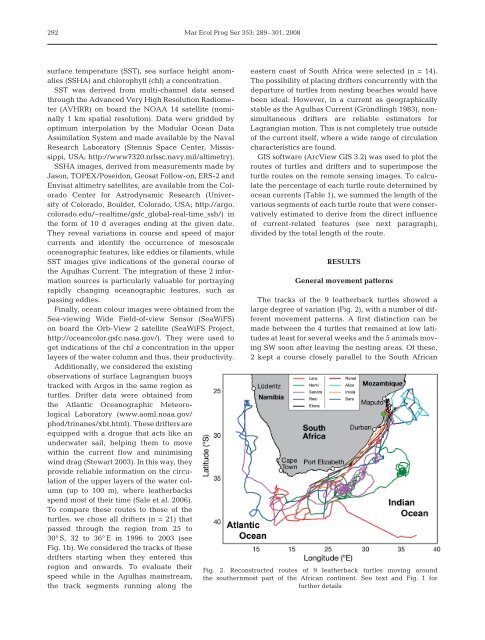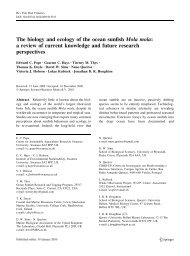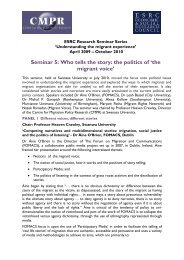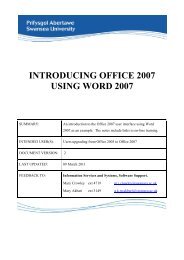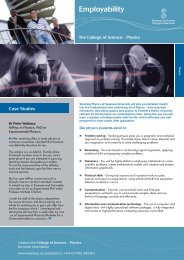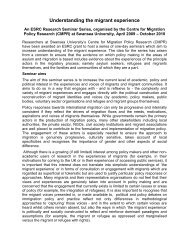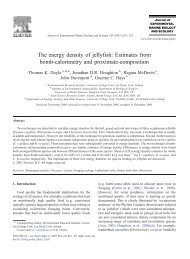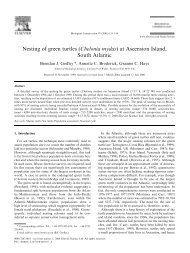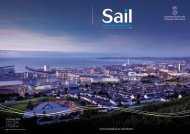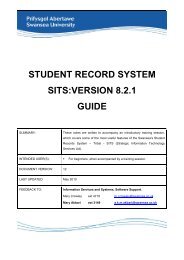Marine Ecology Progress Series 353:289
Marine Ecology Progress Series 353:289
Marine Ecology Progress Series 353:289
Create successful ePaper yourself
Turn your PDF publications into a flip-book with our unique Google optimized e-Paper software.
292<br />
Mar Ecol Prog Ser <strong>353</strong>: <strong>289</strong>–301, 2008<br />
surface temperature (SST), sea surface height anomalies<br />
(SSHA) and chlorophyll (chl) a concentration.<br />
SST was derived from multi-channel data sensed<br />
through the Advanced Very High Resolution Radiometer<br />
(AVHRR) on board the NOAA 14 satellite (nominally<br />
1 km spatial resolution). Data were gridded by<br />
optimum interpolation by the Modular Ocean Data<br />
Assimilation System and made available by the Naval<br />
Research Laboratory (Stennis Space Center, Mississippi,<br />
USA; http://www7320.nrlssc.navy.mil/altimetry).<br />
SSHA images, derived from measurements made by<br />
Jason, TOPEX/Poseidon, Geosat Follow-on, ERS-2 and<br />
Envisat altimetry satellites, are available from the Colorado<br />
Center for Astrodynamic Research (University<br />
of Colorado, Boulder, Colorado, USA; http://argo.<br />
colorado.edu/~realtime/gsfc_global-real-time_ssh/) in<br />
the form of 10 d averages ending at the given date.<br />
They reveal variations in course and speed of major<br />
currents and identify the occurrence of mesoscale<br />
oceanographic features, like eddies or filaments, while<br />
SST images give indications of the general course of<br />
the Agulhas Current. The integration of these 2 information<br />
sources is particularly valuable for portraying<br />
rapidly changing oceanographic features, such as<br />
passing eddies.<br />
Finally, ocean colour images were obtained from the<br />
Sea-viewing Wide Field-of-view Sensor (SeaWiFS)<br />
on board the Orb-View 2 satellite (SeaWiFS Project,<br />
http://oceancolor.gsfc.nasa.gov/). They were used to<br />
get indications of the chl a concentration in the upper<br />
layers of the water column and thus, their productivity.<br />
Additionally, we considered the existing<br />
observations of surface Lagrangian buoys<br />
tracked with Argos in the same region as<br />
turtles. Drifter data were obtained from<br />
the Atlantic Oceanographic Meteorological<br />
Laboratory (www.aoml.noaa.gov/<br />
phod/trinanes/xbt.html). These drifters are<br />
equipped with a drogue that acts like an<br />
underwater sail, helping them to move<br />
within the current flow and minimising<br />
wind drag (Stewart 2003). In this way, they<br />
provide reliable information on the circulation<br />
of the upper layers of the water column<br />
(up to 100 m), where leatherbacks<br />
spend most of their time (Sale et al. 2006).<br />
To compare these routes to those of the<br />
turtles, we chose all drifters (n = 21) that<br />
passed through the region from 25 to<br />
30° S, 32 to 36° E in 1996 to 2003 (see<br />
Fig. 1b). We considered the tracks of these<br />
drifters starting when they entered this<br />
region and onwards. To evaluate their<br />
speed while in the Agulhas mainstream,<br />
the track segments running along the<br />
eastern coast of South Africa were selected (n = 14).<br />
The possibility of placing drifters concurrently with the<br />
departure of turtles from nesting beaches would have<br />
been ideal. However, in a current as geographically<br />
stable as the Agulhas Current (Gründlingh 1983), nonsimultaneous<br />
drifters are reliable estimators for<br />
Lagrangian motion. This is not completely true outside<br />
of the current itself, where a wide range of circulation<br />
characteristics are found.<br />
GIS software (ArcView GIS 3.2) was used to plot the<br />
routes of turtles and drifters and to superimpose the<br />
turtle routes on the remote sensing images. To calculate<br />
the percentage of each turtle route determined by<br />
ocean currents (Table 1), we summed the length of the<br />
various segments of each turtle route that were conservatively<br />
estimated to derive from the direct influence<br />
of current-related features (see next paragraph),<br />
divided by the total length of the route.<br />
RESULTS<br />
General movement patterns<br />
The tracks of the 9 leatherback turtles showed a<br />
large degree of variation (Fig. 2), with a number of different<br />
movement patterns. A first distinction can be<br />
made between the 4 turtles that remained at low latitudes<br />
at least for several weeks and the 5 animals moving<br />
SW soon after leaving the nesting areas. Of these,<br />
2 kept a course closely parallel to the South African<br />
Fig. 2. Reconstructed routes of 9 leatherback turtles moving around<br />
the southernmost part of the African continent. See text and Fig. 1 for<br />
further details


